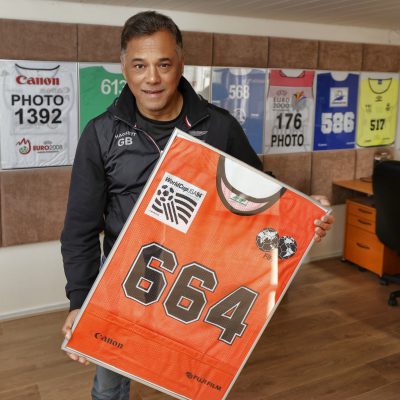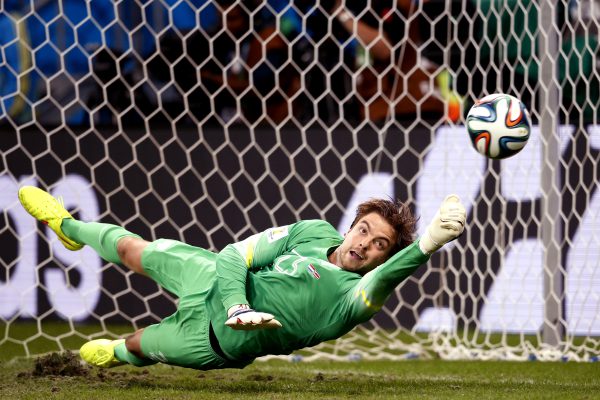He remembers it like yesterday, May 5, 1991 – the day he was invited by a friend to tag along and help take photographs of an Ajax match at their old grounds known as De Meer. He was 27 at the time and doing fine for himself as a sales representative. He manned his friends second camera and in a word, he was hooked. He remembers telling his mother after that experience that we wanted to be a photographer. He had the notion that perhaps he would be better off as his own boss. He was truly enamored with the idea of making his living by combining travel and sport. Some thirty-two years later, it still seems like a good idea. The pins on his map number some 82 countries visited, the lion’s share for work. Stanley Gontha’s eyes, or more importantly the cameras of the sports photojournalist have seen some amazing things.
The first “shoot” was in Diemen for a group of softballers at the club called Survivors. To his surprise, nearly every member of the team bought the photo set he produced, the lone exception simply forgot to bring her money when the photos were delivered. Gontha’s first company, BS Promotions was born. He found out that taking photos of amateur athletes was a lucrative business although he confided that sales were best the lower down the athletic prowess ladder he went. Gontha chuckles at the thought that BS Promotions might have drawn a wry grin for English speakers so when he made the jump to photographing full time, he chose the name to Pro Shots, which not only survived but flourishes to this day.
The real turning point in his journey took place in 1994 when the FIFA World Cup was held in the United States. The trip was always going to be a significant financial layout and Gontha worried that he would not be able to cover the expenditures through sales of press photos alone. The budding entrepreneur managed to convince a courier company who was looking for a sponsor activation to avail themselves of his services. He managed to find several takers and turned a profit on the World Cup even though Oranje had bombed out, thanks in part to sitting on the tarmac at the airport after an accompanying journalist mentioned the word bomb to a stewardess. Gontha was not on that plane, whose delay was widely blamed for Holland’s elimination from the ‘94 Cup at the hands of Brazil.
One of the biggest changes in the course of Gontha’s career as a photog was the transition from analog (film) photography to digital. A match between Valencia and Ajax in the 2002-03 UEFA Champions League proved to be a watershed moment. Ajax’s Zlatan Ibrahimović scored the 1-1 equalizer in the 88th minute. Directly after the match, Gontha was sending the digital image of the Swedish international using the modem in his Nokia cell phone. An hour and a half liter of perspiration later, the image was sent and to Stanley’s delight, the Stockholm newspaper ran his photo in the morning edition.
By the time the press center at the 2002 World Cup in Korea opened its doors, the transition to digital was truly manifest. Gone was the traditional Kodak film processing center. No more bags were distributed for films rolls and the several hundred photos per photographer shot to analog film were replaced by several thousand files on bulky memory devices. Momma had truly taken the Kodachrome away.
It’s easy to think that shooting footballers on servo or automatic mode, snapping away at 7 frames per second, will yield results yet it belies the skill of an experienced sports photographer. Gontha, who considers himself a photojournalist, relies on his knowledge of the game and years of experience in getting the “money shots” which have adorned the front pages of the Dutch and international press for three decades. Together, with his contemporaries, Guus Dubbleman, Pim Ras, and Matty van Wijnbergen, he is one of the elder statesmen behind the goals. They joke amongst themselves that they travel more with each other than with their spouses.
All kidding aside, the competition is fierce and attention to detail as well as the ability to maintain focus (literally as well as figuratively) are essential. Sometimes, however, a bit of intuition and luck go a long way to getting an iconic photo. Gontha remembers the details surrounding his favorite shots taken during the penalties in the match between the Netherlands and Costa Rica at the 2014 FIFA World Cup in Brazil. Gontha realized that Dutch trainer Louis van Gaal’s decision to substitute keeper Jasper Cillessen with Tim Krul would be an iconic moment. While the top photographers normally shoot from behind the goal to capture goal scores head on, Gontha realized the story would be the success or failure of the Dutch keeper and chose to stay at midfield to register the keeper, face forward. His strategy paid off and Stanley Gontha’s shots of Tim Krul securing the Dutch victory adorned the covers and pages of many newspapers and magazines as a testament to the genius of Louis van Gaal and the intuition of an experienced photojournalist.
Stanley Gontha has come full circle. He is an employee again having sold his business to a major publishing house. When he is not working in a stadium, he works from home, the walls of his office adorned with photographer’s vests from major events he has covered including the 1994 World Cup in the U.S, where it all started. These days, he can even enjoy a long lunch, catching with an old acquaintance he got to know during a foray into an entirely different sport, namely, American Football. But the beautiful game has always been his calling and he had never strayed far from footy even after a bought with some health issues had sidelined him. One can imagine that photographing a football match for two hours crouched behind a camera is physically demanding. Gontha confirmed that it is not the most ergonomic workplace. Shooting his 8th FIFA World Cup last year, Gontha remarked that the air-cooling systems that had been installed the Qatari stadia were not only up to the job but in fact overperforming. The air conditioners had been designed for the full brunt of the oppressive summer heat of the Gulf but the competition had been moved to November to mitigate fears of players dropping on the pitch due to heat prostration. Having taken up his familiar position behind goal, he noticed the flow from the stadium’s air nozzles was worse than a draughty chimney. He asked one of the hostesses positioned near the photographers if the situation could be remedied. She replied cheerfully that he could indeed exit the stadium if he felt chilly! As long as Stanley Gontha is able to bring top football into focus, he won’t be leaving the building just yet.
Written by John Mahnen

